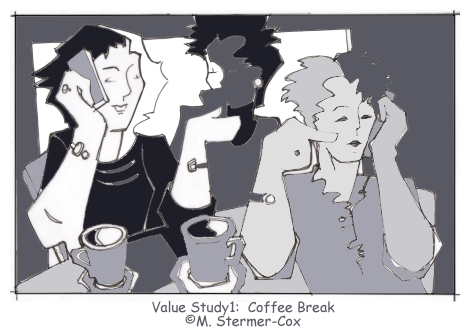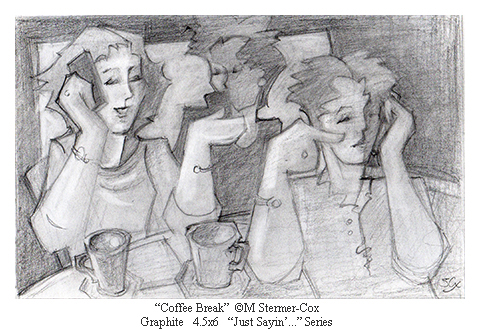November is Value Study Month
Earlier this month, I declared November to be “Value Study” month. And, yet, I haven’t posted many studies. Time for me to fix this problem! By the way, do you create value studies?
Bottomline
Value studies help me analyze and develop my designs. Its like creating a visual road map prior to paint hitting the paper. By doing this step, I am more likely to create a watercolor painting that I love.
“Coffee Break” Is the Design I’ll Be Working On
I have been working on a new drawings for my “Just Sayin’…” series of paintings. I’m expanding to include multiple figures talking on cell phones and embracing our modern communications technology. This is one such drawing. I am inspired by visits to coffee shops and cafes where I see friends sitting together with cell phones engaged. Perhaps they’re talking to each other?
What do you think, is this drawing ready to become a painting? Sometimes I go to work just by using the first sketch. However, I have found that it really helps if I define the shapes and do some value studies prior to beginning the painting process.
Make A Cartoon Template Then Fill Shapes
My value study process involves making a “cartoon” or line drawn template of my original drawing. I want to turn the drawing into shapes that I can “fill” with a various grays.
Why are shapes so important?
I find that seeing and designing in shapes makes for a stronger composition. Plus, I get my mind going and try different options.
Design Your Center Of Interest With Values
For example, with this composition, I can make either the right or left figure my center of interest. The gestures are interesting. In study #3 above, the left figure stands out. In the figure below, the right figure is more dominant. I use my light and dark patterns to direct your attention.
If you scroll through the images, you’ll see that I tend to make the left figure dominant. It is only in study #2 that she is not the main subject.
Orchestrate Subordinate Players With Less Contrast
Once I’ve decided where my center of interest is and who is dominant, I need to design how I’d like my subordinate players to fit in. When using the tool of value, I will reduce the contrast in middle and right figures so I can direct your attention to the left.
One thing I like about value studies is that I can get a sense of the design before I ever put brush to paper. I still think while I paint, allowing things to flow. But, it does help to know where you’re going.
Technical “How To” Information
If you’re new to value studies and want to try on your own designs, here is what I recommend.
- Trace your own drawing on to tracing paper.
- Once you have “outline” only, copy the tracing. Make as many copies as you like.
- With gray scale markers, felt tip pins or crayons, fill the shapes.
I often find that the first study I do is not the most creative. I have to get the obvious solutions out of the way before I can try something inventive.
How I Created My Value Studies
- I made an outline of my drawing using tracing paper and black fine tip markers. I made sure the shapes were completely enclosed by a line.
- I scanned my tracing into the computer.
- Using a computer paint program, in this case “Corel Painter 11”, I opened the files and made copies.*
- Then, using the bucket tool, I fill the shapes.
- I saved each option and did another one!
- I like to give myself at least three value studies to consider.
*Even though I use Corel Painter 11, I imagine other programs will work just fine.
Alternatives
This is not the only way to do a value study. Sometimes I just play with pencil and paper. I’d like to share a link to David Kessler’s blog article “Value Studies: The Artist’s Essential Tool”. Here’s a different way to create studies.
Bottomline Restated
Value studies help me analyze and develop my designs. By doing this step, I am more likely to create a watercolor painting that I love.




